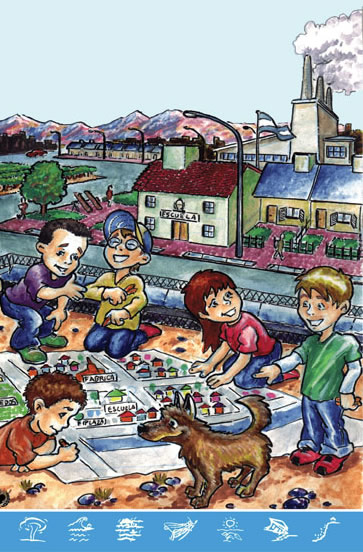Learning to prevent disasters – A local adaptation for Maipú, Mendoza, Argentina
“This material aims to provide teachers and children in Latin America and the Caribbean with an innovative and interactive risk management tool.” These words are included in the latest edition of the booklet titled Learning to Prevent Disasters! produced in the Municipality of Maipú, Mendoza, Argentina. Respecting the original design and most of the contents, the booklet was adapted for schools in Maipú. The original material included in the Riskland game was developed by the UN/ISDR and UNICEF/TACRO, with the contribution of several individuals and institutions. Gloria Bratschi (content supervisor), Ana Sevilla (institutional supervisor representing the Municipality of Maipú), and Damián Pérez Santos (cartoonist) were in charge of this new publication.
 |
|
In this area of the province of Mendoza, as well as in the rest of the Cuya region, everyday life is different from that depicted in the original booklet. Certain aspects of the Mendoza idiosyncrasy were added for educational purposes, so that children in Mendoza could relate to their own reality, as well as that of the Americas, from a risk management perspective. This link to our surroundings also determines the cognitive and learning actions needed to consolidate a risk prevention culture, since the recipients of this educational tool have to identify the natural and technological hazards with which they normally coexist in the region.
Formal education in Mendoza can now resort to this very handy tool adapted to better understand existing natural and technological hazards. By using it, students can acquire, at a very early age, the knowledge needed to promote attitudes and behavior for disaster risk reduction. Schools are able to form, in a systematic manner, citizens committed to risk management, sustainable development, and environmental issues. They can also learn how natural and anthropogenic hazards can lead to disasters.
In adapting the booklet, the team first analyzed the original version, taking upon the following steps: trans-coding of visual communication, under a criterion of “native representation”; the inclusion of socio-cultural icons surrounding landscape, flora, fauna and human activities; the use of typical Mendoza tones and colors in the illustrations; the inclusion of local ethnic features to foster a broader sense of belonging; the combination of original drawings from the booklet and new ones; an aesthetic balance to mantain the original Latin American purpose of the publication along with the inclusion of risks specific to Maipú and Mendoza in general, such as zonda winds and mudslides, in addition to those already listed in the booklet.
|
The Municipality of Maipú published the copies that were given to local school principals and supervisors during a public event. Furthermore, a local risk management training course is currently being designed and will soon be used in the classrooms.
Such efforts draw on the Hyogo Framework for Action and the Millennium Development Goals, and aim to contribute to the campaign titled “Disaster Risk Reduction Begins at School”, with the understanding that education for sustainable development will help reduce our vulnerabilities and promote the interest and commitment of individuals and all sectors of society, in favor of a better quality of life and a sustained attitude that will allow for the mitigation of disaster risks.
Gloria Bratschi, International Risk Prevention Consultant
gloria_bratschi2003@yahoo.com.ar ; gbrat@lanet.com.ar
Ana Sevilla, Institutional Management, Municipality of Maipú, Mendoza, Argentina
anajapaz@yahoo.com.ar ; ginstitucional@maipu.gov.ar
1Translator’s note: Zonda is a regional term that refers to a dry wind that descends the eastern slopes of the Andes.
|

